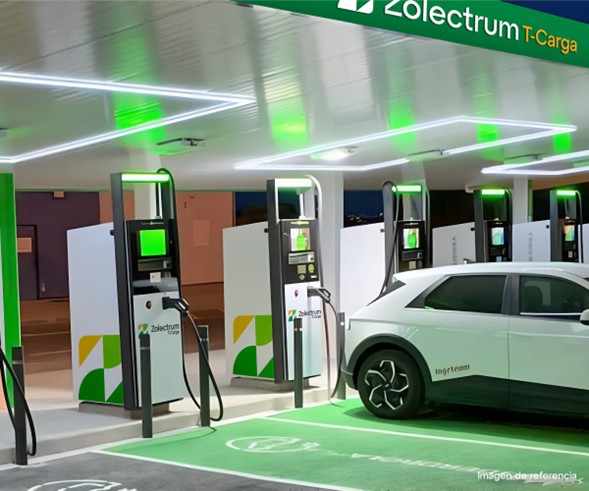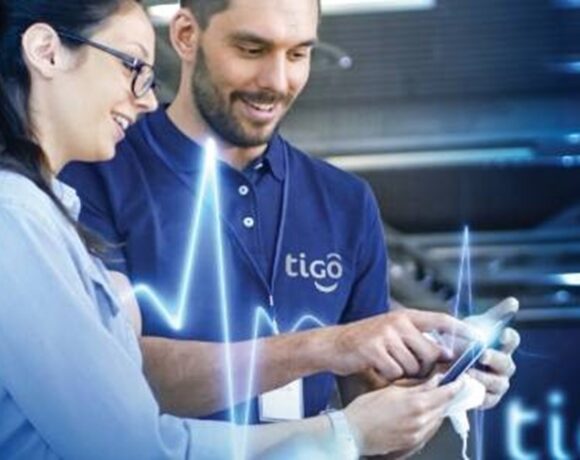Electric-Vehicle Buying Surge Here Prompts EV-Recharge Startup Response

Electric vehicles (EVs) last year were hardly seen on streets and highways around metro Medellin, an area where more-than-1-million conventional motorcycles, cars, trucks and buses circulate.
But 2025 has driven a remarkably big surge in purchases of EVs here — mainly for amazingly cheap BYD models from China – and that’s prompting investors to take a much-more-serious look at building EV recharge stations for this growing EV fleet.
One such company here is Zolectrum (see photo above, actually a mock-up of the company’s envisioned future EV-recharge-stations).
Zolectrum is founded by veteran technology investor and CEO Joaquin Ruiseco, along with Chief Technology Officer Mauricio Orjuela, Finance Director Gustavo Hurtado and Marketing Manager Nicolas Muñoz.
EV buyers know that by far, the easiest pathway for routine recharging is at home — in the garage or on the driveway.
But in most of Medellin and elsewhere around Colombia, that isn’t easy or even available.
Reason: Most people here live in apartment buildings with shared parking, or in row houses lacking garages.
So: installing EV rechargers in common-area parking lots or on street-sides – then connecting chargers via cables to electric meters inside individual apartments – would be costly and complex, as wisely explained at the Cyberswitching web site (see: https://cyberswitching.com/electric-car-charging-in-multifamily-residential-buildings-challenges-and-solutions/?srsltid=AfmBOoo1tr1lLTij2rVz845HSv2cvzLDJJlb_MLvU094F7cCg3fU_LNE).
However, at an August 27 EV-recharge workshop here at Medellin’s Museo del Transporte – led by Zolectrum CTO Orjuela – one audience participant explained how he helped lead a joint effort at his apartment complex to create a novel, shared EV-recharge scheme, whereby EV owners alternate certain days or hours of the week to recharge their vehicles at a few dedicated EV parking spaces.
But that isn’t always feasible, as many residents in apartment buildings – those who don’t own EVs and don’t want to share the cost of recharge installations and complex wiring inside buildings – could readily block installations.
What’s more, as Cyberswitching notes, “many older multifamily buildings may lack the necessary electrical capacity, necessitating costly upgrades to accommodate EV charging.”
In addition, “implementing a fair and transparent billing system for EV charging usage among residents can be complex. Property managers must devise a system that accurately tracks individual usage and allocates costs accordingly.”
What’s more, “multifamily residential buildings must comply with building codes, zoning regulations, and homeowner association rules when installing EV charging infrastructure.”
Possible solutions, according to Cyberswitching, include “shared charging stations” featuring “dynamic scheduling capabilities that can optimize the use of limited parking spaces.”
In addition, “smart charging management systems” could be installed, which “enable remote monitoring, billing, and scheduling of charging sessions” and also provide “real-time data on charging station usage, automated billing processes, and optimized charging schedules to minimize energy costs.”
On the other hand, installing EV recharging-and-metering systems during construction at new apartments and other new buildings would be much-less-complicated than retrofitting. In fact, new-build recharging installations are starting to happen here much more frequently.
In the meantime, a relative handful of public EV recharge stations have appeared here to serve vehicles lacking home recharging, or for vehicles needing a recharge distant from home recharging.
To date, Medellin-based electric utility EPM, electric power supplier Celsia, gasoline-station-chain Terpel and a handful of others have installed a relatively few public EV recharge stations — not for older apartments and buildings where most people live, but rather mainly at shopping centers, airports, corporate sites and certain refueling stations, as well as at some individual homes.
However, these relatively small efforts are often seen as a form of “green” publicity, in contrast to some yet-to-emerge, large-scale, commercial recharge business.
So, expanding public recharge sites for an emerging boom in EV sales is where Zolectrum plans to step in — possibly as one of the first of many future such innovators aiming to serve Colombia’s growing EV fleets.
Here is what Zolectrum’s CEO Ruiseco and Marketing Manager Muñoz told Medellin Herald in follow-up questions following the Museo del Transporte workshop:
Medellin Herald: As you have explained, Zolectrum is a startup that isn’t yet fully operational. But on Zolectrum’s website, there are various photos including one of a charging station (see above) that could give the impression that Zolectrum is already operating as a commercial business. Clarify?
Ruiseco: These are provisional reference images. They are mockups based on the equipment we purchased. These will arrive here branded with our image.
Medellin Herald: You explained that you initially plan to introduce three types of chargers in Colombia — two of which are “semi-fast” at 22 kilowatts (kW), but the third would be “ultra-fast” at over 50 kW, correct? The “semi-rapid” chargers are for shopping centers, parking lots, etcetera — not for rapid charging as for example alongside the Medellín-Bogota highway near Puerto Triunfo, correct?
Ruiseco: Correct. (The “semi-rapid” chargers are for shopping centers, parking lots, etcetera). The 160 kW rapid chargers are for intercity buses.
Medellin Herald: Zolectrum is going to import all the chargers from China, correct?
Ruiseco: Yes.
Medellin Herald: Are there other companies in Colombia that employ Zolectrum’s business model so far?
Ruiseco: Yes, initially with energy providers like EPM. Later, we will have our own, new, solar-photovoltaic farms [to support new EV recharge stations].
Medellin Herald: Do you plan to install new solar panels or use existing panels at all facilities, or only in certain situations? If there is no feasible option to use or install solar panels, then Zolectrum will purchase electricity from providers like EPM, correct?
Ruiseco: Yes (Zolectrum would purchase power wherever needed).
Medellin Herald: Can you estimate a total cost for a “typical” Zolectrum installation, or at least a range of costs?
Ruiseco: Installation costs vary greatly because they depend on the available electricity. If there is already an infrastructure that provides the necessary electric energy, then it is only the cost of the equipment and civil works to comply with the “RETIE” electrical code.
If the necessary infrastructure is not available, then costs can be very high as these depend on the available options. This can range from transformers to solar farms and energy storage via BESS (Battery Energy Storage Systems). That’s why each installation project is carefully considered to develop its return on investment.
Medellin Herald: How many electric vehicles are currently circulating in Colombia?
Ruiseco: By 2024, as of July, we had approximately 21,000 fully electric vehicles and more than 28,000 plug-in hybrids in Colombia, according to data from ANDEMOS, the National Association for Sustainable Mobility.
Electric motorcycles exceed 17,000 registered units. Considering the above, the growth that has been taking place reflects sustained progress, but it is still small or slow when compared to the total number of vehicles in the country.
Medellin Herald: Is it true that in Colombia, BYD now sells more than 4,000 electric vehicles per month?
Ruiseco: Indeed, BYD has surprised the Colombian market. In the first half of 2025, that brand has sold an average of more than 4,000 EV units per month, consolidating its position as the leader in the electric vehicle segment in Colombia.
This is due to a combination of factors, such as more affordable prices thanks to economies of scale and subsidies from the Chinese government, greater range, better technology, and a shift in perception among Colombian consumers who now view EVs as a viable option, not a luxury.
Medellin Herald: Who is buying these electric vehicles? Only the wealthier strata?
Ruiseco: Although the first buyers were mainly from the higher 5th- and 6th-strata income brackets, the market has been expanding to the middle class (3rd and 4th income brackets), especially through models like BYD’s Dolphin Mini, which costs around COP$80 million [US$20,050]. In addition, there are leasing companies and financing programs that allow more people to access EVs, which democratizes this transition.
Medellin Herald: Is the national government’s goal of 300,000 EVs in Colombia by 2030 realistic?
Ruiseco: Yes, of course, but that requires a coordinated effort from various parties. Today we are far from that figure, but the current exponential growth, such as sales doubling year after year, suggests that with the right policies, tax incentives, and the development of charging infrastructure, the goal of 300,000 electric vehicles by 2030 is achievable.
Medellin Herald: The big challenge of recharging EVs in Medellin is in residential buildings, correct?
Ruiseco: Yes, one of the biggest challenges to the mass adoption of EVs in cities like Medellín is charging in residential complexes and buildings. In many condominiums, parking lots are distant from individual meters, and structural changes [including installing new cabling systems] are not allowed without approval from the building-owners’ assemblies.
However, there are already new regulations in Bogotá and Medellín requiring EV charging infrastructure in new construction.
Medellin Herald: Is sharing EV chargers among neighbors a good solution?
Ruiseco: It is a viable solution, especially in well-organized residential condominiums. However, many buildings require something more automated and less dependent on human management.
Medellin Herald: How much additional electricity will Colombia need for assumed EV growth here over the next 10 years?
Ruiseco: Estimates vary depending on the installation locations. Colombia is estimated to need between 1,000-MW and 1,200-MW of additional installed capacity to cover EV charging demand in 2035.
This is not an overwhelming amount: it represents less-than-10% of the current installed capacity (~19,000-MW). However, investment is needed now in smart grids, battery storage, and load balancing.
Medellin Herald: What should be done about expanding electric power supply here, given the difficulty of building new hydroelectric plants in Colombia?
Ruiseco: Given the social rejection of large hydroelectric plants like Hidroituango and the environmental risks, Colombia must accelerate the diversification of its energy matrix.
This includes large-scale solar energy, wind power (offshore and in La Guajira), backup thermal plants, and storage solutions such as industrial batteries. In addition, distribution efficiency must be improved to avoid technical losses, which currently exceed 15% in some regions.
Medellin Herald: What should be done to address future possible energy shortages here arising from new, very-large-scale energy consumers?
Ruiseco: Although future large-scale electric-power consumers such as data centers are not yet a critical factor in Colombia, we must anticipate them.
The most important thing is to develop distributed generation, especially solar energy on residential, commercial, and industrial rooftops. We must also promote energy efficiency and support initiatives or laws that promote new, more sustainable, and decentralized ways of producing and using energy on a small scale.
Medellin Herald: What new EV charging technologies are coming?
Ruiseco: Among the most promising are:
(1) bidirectional (V2G) chargers, which allow the vehicle to inject energy into the grid or into the home;
(2) ultra-fast direct current (DC) charging;
(3) smart chargers with dynamic energy management, which optimize grid use based on price and demand.
These technologies are already being tested in Colombia, and some will be part of the pilot projects we will lead at Zolectrum.
















